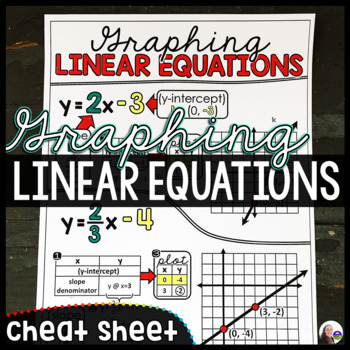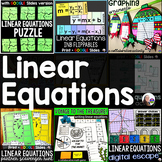Graphing Linear Equations Slope-Intercept Form One Pager Algebra 1 Cheat Sheet
21,093 Downloads
Scaffolded Math and Science
30.4k Followers
Resource Type
Standards
CCSS8.F.A.2
CCSS8.F.A.3
CCSS8.F.B.4
CCSSHSA-REI.D.10
Formats Included
- PDF
Pages
1 page
Scaffolded Math and Science
30.4k Followers
Also included in
- This bundle includes a variety of interactive printable and digital linear equations activities that will keep your students engaged as they are learning, practicing an reviewing linear equations. Inside this bundle are digital math escape rooms, math pennants, a linear equation project, partner scaPrice $27.00Original Price $44.50Save $17.50
Description
This math cheat sheet walks students through graphing linear equations by identifying the y-intercept, creating a table, and plotting the coordinates onto the coordinate plane. If you have students struggling to graph linear equations, this reference sheet can be slipped into their math notebooks or even enlarged to become an anchor chart (directions inside).
Included in: Algebra Activities Bundle
You may also like:
Graphing Linear Equations Digital Math Escape Room
Total Pages
1 page
Answer Key
N/A
Teaching Duration
N/A
Report this resource to TPT
Reported resources will be reviewed by our team. Report this resource to let us know if this resource violates TPT’s content guidelines.
Standards
to see state-specific standards (only available in the US).
CCSS8.F.A.2
Compare properties of two functions each represented in a different way (algebraically, graphically, numerically in tables, or by verbal descriptions). For example, given a linear function represented by a table of values and a linear function represented by an algebraic expression, determine which function has the greater rate of change.
CCSS8.F.A.3
Interpret the equation 𝘺 = 𝘮𝘹 + 𝘣 as defining a linear function, whose graph is a straight line; give examples of functions that are not linear. For example, the function 𝘈 = 𝑠² giving the area of a square as a function of its side length is not linear because its graph contains the points (1,1), (2,4) and (3,9), which are not on a straight line.
CCSS8.F.B.4
Construct a function to model a linear relationship between two quantities. Determine the rate of change and initial value of the function from a description of a relationship or from two (𝘹, 𝘺) values, including reading these from a table or from a graph. Interpret the rate of change and initial value of a linear function in terms of the situation it models, and in terms of its graph or a table of values.
CCSSHSA-REI.D.10
Understand that the graph of an equation in two variables is the set of all its solutions plotted in the coordinate plane, often forming a curve (which could be a line).





